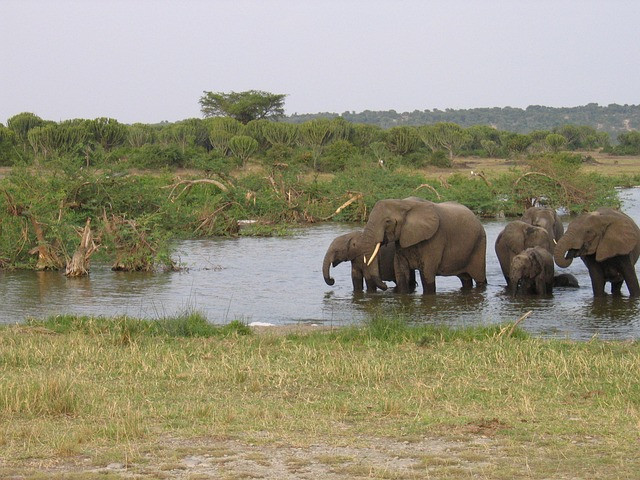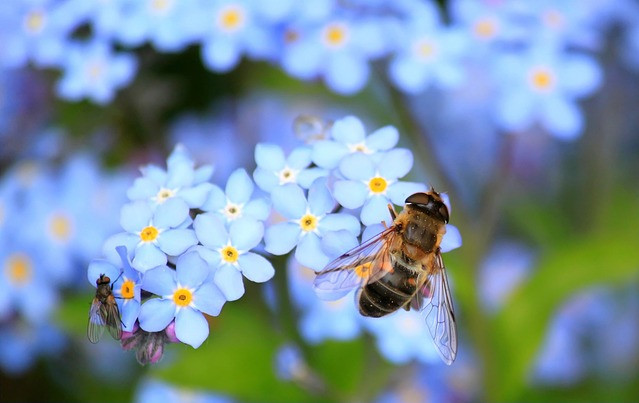Embracing Nature’s Richness: The Importance of Biodiversity and 25 Best Ways to Preserve It
Today, we’re delving into a crucial topic that holds the key to the diversity of life on our planet – biodiversity. Nature has blessed us with awesome array of animals, plants, and ecosystems, with each one playing a unique role in maintaining the delicate balance of Earth – our home.

Image source: Amzschmidt, Pixabay
According to National Geographic, scientists have estimated that there are around 8.7 million species of plants and animals in existence. However, only around 1.2 million species have been identified and described so far, most of which are insects.
In this blog post, we’ll explore the following:
- History of The Term Biodiversity
- What is Biodiversity?
- Why is Biodiversity Good For Us?
- 25 Best Ways to Preserve Biodiversity At Home
History of the Term Biodiversity
The history of the term biodiversity dates as far back as several years ago. Let’s have a look:
- 1916 – The term biological diversity was used first by J. Arthur Harris.
- 1967 – Raymond F. Dasmann used the term biological diversity in reference to the richness of living nature that conservationists should protect in his book A Different Kind of Country.
- 1974 – The term natural diversity was introduced by John Terborgh.
- 1980 – Thomas Lovejoy introduced the term biological diversity to the scientific community in a book and it quickly became commonly used.
- 1985 – According to Edward O. Wilson, the contracted form biodiversity was coined by W. G. Rosen.
- 1985 – The term “biodiversity” appeared in the article, “A New Plan to Conserve the Earth’s Biota” by Laura Tangley.
- 1988 to Present – The United Nations Environment Programme (UNEP) Ad Hoc Working Group of Experts on Biological Diversity began working in November 1988, leading to the publication of the draft Convention on Biological Diversity in May 1992. Since this time, there have been 15 Conferences of the Parties (COPs) to discuss potential global political responses to biodiversity loss. Most recently COP 15 in Montreal, Canada in 2022.
What is Biodiversity?
 Image source: Cocoparisienne, Pixabay
Image source: Cocoparisienne, Pixabay
Biodiversity refers to the variety and abundance of living organisms in a given area; this encompasses animals, plants, microorganisms, and ecosystems.
Simply put, Biodiversity is about local ecosystems and promoting healthy conditions for organisms to thrive.
Biodiversity is vital for ecosystem stability, food security, medicine, climate regulation, and the well-being of all life on our planet. Preserving biodiversity is essential to sustain life and protect the natural balance of our environment.
Why is Biodiversity Good for Us?
Here are 5 reasons why biodiversity is important for our survival:
1. Ecosystem Stability:

Image source: Rob, Unsplash
Biodiversity plays a vital role in maintaining the stability of ecosystems, strengthening their ability to withstand environmental changes like natural disasters and climate fluctuations. Every species contributes to the intricate web of life, and their interactions are essential for the proper functioning of ecosystems.
2. Medicine and Healthcare:

Image source: Janvanbizar, pixabay
Many of the medicines we rely on come from plants, animals, and microorganisms found in nature. Preserving biodiversity is crucial for future medical discoveries and advancements in healthcare.
3. Food Security:

Image source: Natalie Walters, Unsplash
Food security is bolstered by a diverse array of crops and livestock species. Biodiversity in agriculture guards against relying too much on a single food source and enables us to adapt to shifting environmental conditions.
4. Soil Fertility:

Image source: Ivabalk, Pixabay
The diversity of plant species enriches the soil, enhancing its fertility and productivity. Healthy soils are vital for agriculture and supporting life on Earth.
5. Climate Regulation:
Forests, oceans, and wetlands serve as carbon sinks, absorbing greenhouse gases and regulating our climate. Preserving biodiversity is vital in the fight against climate change, as it helps mitigate its adverse impacts.
25 Best Ways to Preserve Biodiversity at Home:
Climate change, Pollution and population growth are threats to biodiversity. But all hope is not lost; here are 25 simple ways you can promote and preserve local biodiversity at home.
1. Support Local Farmers and Sustainable Agriculture:

Image source: Dan Meyers, Unsplash
Choose locally grown, organic produce to support farmers who adopt eco-friendly practices that promote biodiversity. Supporting local farmers and sustainable agriculture helps promote biodiversity by preserving native plant species and wildlife habitats, fostering crop diversity and genetic resilience, improving soil health to support diverse microbial communities, and reducing habitat deforestation, thereby preserving biodiversity hotspots.
2. Create a Wildlife-Friendly Garden:

Image source: Kelly Sikkema, Unsplash
You can transform your backyard into a haven for wildlife by planting native plants and providing water, food sources, and shelter for insects, birds, and other creatures. Creating a wildlife-friendly garden is indeed an effective way to promote biodiversity. You can provide food and shelter for local wildlife, attracting butterflies, bees, and birds by incorporating native plants.
Avoiding the use of harmful pesticides and chemicals ensures the well-being of these creatures and supports their vital roles in pollination and pest control. Adding features like bird feeders, bird baths, and nesting boxes further enhance the garden’s appeal to wildlife.
3. Reduce, Reuse, Recycle:

Image source: Shirley810, Pixabay
Embrace the three Rs in your daily life to minimize waste, conserve resources, and reduce the impact on natural habitats. In other words, practicing the three Rs – Reduce, Reuse, Recycle can help conserve biodiversity by lessening our ecological footprint and preserving the delicate balance of ecosystems that sustains a wide range of life on planet earth – our home.
4. Embrace Composting:
Turn kitchen and garden waste into nutrient-rich compost, enriching the soil and supporting diverse plant life.
By incorporating composting practices, we can actively promote biodiversity by supporting healthy soils, providing habitats for wildlife, reducing waste, and conserving natural resources.
5. Protect Wetlands and Waterways:

Image Source: Engel, Pixabay
Protecting wetlands and waterways is vital for promoting biodiversity. Wetlands are incredibly biodiverse ecosystems, serving as habitats for a wide variety of plant and animal species, including migratory birds and aquatic life. By preserving these areas and implementing conservation measures, we safeguard the delicate balance of these ecosystems, preventing habitat loss and ensuring the survival of many vulnerable species.
6. Participate in Citizen Science Projects:
You can get involved in citizen science initiatives to monitor and collect data on biodiversity, contributing to valuable research efforts. Examples of Citizen Science Projects include: eBird, iNaturalist, The Great Backyard Count and Frogwatch USA.
7. Adopt a Plastic-Free Lifestyle:

Image Source: Sandra Harris, Unsplash
You can help promote biodiversity by reducing single-use plastic consumption to protect marine life and prevent plastic pollution from harming ecosystems. Adopting a plastic-free lifestyle can promote biodiversity significantly!
Plastic debris can entangle wildlife, and leach harmful chemicals into the environment. Opting for reusable alternatives, like glass or metal containers reduces plastic pollution and its harmful effects on biodiversity. Eliminating single-use plastics can also help preserve resources and reduce the demand for fossil fuels used in the production plastic, further contributing to the protection of biodiversity and the preservation of our ecosystems.
8. Educate Others:

Image Source: Vanessa, Unsplash
You can spread awareness about the importance of biodiversity and inspire others to take action in protecting it. Promoting biodiversity through education involves raising awareness about the importance of preserving diverse ecosystems and the threats faced by various species.
9. Volunteer with Conservation Organizations:

Image Source: Ray Sangga kusuma, Unsplash
There are so many conservation organizations. A hands-on way to make a positive impact on the environment is by promoting biodiversity through volunteering with conservation organizations.
Join local conservation groups or wildlife reserves to actively participate in protecting biodiversity. You can contribute directly to the preservation of biodiversity by dedicating some time and effort to projects like tree planting, habitat restoration, and wildlife monitoring.
10. Practice Responsible Tourism:

Image Source: Michelle_Raponi, Pixabay
Choose eco-friendly and sustainable tourism options that prioritize wildlife protection and habitat conservation.
By participating in sustainable tours, choosing eco-friendly accommodations, and supporting local businesses, we can minimize our carbon footprint and preserve natural habitats.
11. Learn About Indigenous Species:

Image Source: Boys in Bristol Photography, Unsplash
Discover and appreciate the unique flora and fauna native to your region, understanding their significance in the local ecosystem. Consider educating yourself about these unique and often threatened animals, plants and microorganisms; this helps raise awareness of their importance, fostering conservation efforts to protect their habitats and ensure their survival.
12. Install Bird-Friendly Window Decals:

Image Source: Damon Hall, Unsplash
You can help prevent bird collisions and create a safe environment for them by placing window decals that make glass visible to birds, reducing accidental injuries. By reducing fatal impacts, these impactful actions contribute to preserving bird populations and their ecological roles, such as insect control.
13. Support Marine Protected Areas (MPAs):

Image Source: NOAA, Unsplash
MPAs are designated areas where human activities are restricted to protect marine life and their habitats. Supporting Marine Protected Areas (MPAs) is crucial for conserving our oceans’ health and biodiversity.
You can help by advocating for the creation and expansion of MPAs, supporting organizations dedicated to marine conservation, and participating in beach cleanups to reduce pollution and preserve marine life.
14. Reduce Meat Consumption:

Image Source: Food Photographer, Unsplash
Livestock farming is a leading cause of deforestation and habitat loss. You can promote biodiversity with a simple change in your diet, such as reducing meat consumption and opting for plant-based alternatives. Embracing a plant based diet is not only beneficial for our health but also supports a thriving and diverse natural world.
15. Encourage Eco-Friendly Fishing:

Image Source: Chris Abney, Unsplash
Support sustainable fishing practices that protect marine biodiversity and prevent overfishing. Sustainable fishing methods, such as using selective gear, and implementing catch limits, help preserve fish populations. Consuming seafood with eco-certifications, like MSC (Marine Stewardship Council), ensures that fish come from sustainable sources.
16. Restore Native Habitats:

Image Source: Pat Whelen Unsplash
Consider engaging in habitat restoration projects to bring back native plants and animals to their original ecosystems.
Promoting biodiversity involves restoring native habitats.
You can create suitable homes for local wildlife, supporting their populations and ecological interactions by replanting native vegetation. Restoring forests, and grasslands enhances biodiversity and also improves ecosystem resilience and mitigates the effects of climate change.
17. Reduce Light Pollution:

Image Source: Pexels, Pixabay
Turn off unnecessary outdoor lights to protect nocturnal animals and their natural behaviors. By using energy-efficient and properly directed outdoor lighting, we can minimize the adverse effects of artificial light on wildlife behavior and habitats.
Shielding lights and using low-intensity illumination near natural areas help nocturnal species thrive and maintain their natural behavior. For example, adopting responsible lighting practices, creates safer migration pathways for birds.
18. Practice Responsible Pet Ownership:

Image Source: Humberto Arellano, Unsplash
Adopt pets from shelters and provide responsible care to prevent the spread of invasive species and protect local wildlife. Keeping pets indoors or on a leash while outdoors prevents them from preying on wildlife and disturbing natural habitats.
19. Advocate for Environmental Policies:

Image Source: Naja Bertolt Jensen, Unsplash
Support policies and legislation that prioritize biodiversity conservation and sustainable development. Supporting measures that protect natural habitats, and regulate harmful practices helps conserve biodiversity on a larger scale. By engaging in grassroots efforts, and voicing concerns to policymakers, we can influence positive change.
20. Support Wildlife Rehabilitation Centers:

Image Source: Francisgoh, Pixabay
Wildlife Rehabilitation Centers rescue, rehabilitate, and release injured or orphaned animals back into their natural habitats so; a fantastic way to promote biodiversity and make a real difference for our furry and feathered friends is by supporting these centers.
Consider donating to these organizations or volunteering your time, and in so doing, you contribute to the care and conservation of diverse wildlife species. Also, spreading awareness about their work helps educate others about the importance of protecting our local ecosystems and the wildlife that calls them home.
21. Go on Nature Walks:

Image Source: Kelly Sikkema, Unsplash
This gives you the opportunity to explore nature trails and appreciate the wonders of the natural world. Going on nature walks is indeed a great way to promote biodiversity while immersing yourself in the beauty of the outdoors!
These walks offer lots of opportunities to learn about the importance of preserving natural habitats and the diverse species that inhabit them.
22. Reduce Water Usage:

Image Source: kaboompics, Pixabay
The most important thing here is to be mindful of your daily water consumption. This way, you’re able to conserve water to protect aquatic ecosystems and the species that depend on them. We can preserve this precious resource for humans and wildlife by using water-saving fixtures and fixing leaks.
Reducing water usage helps maintain healthy ecosystems by ensuring there’s enough water for animals, plants, and aquatic life to thrive.
23. Encourage School and Community Gardens:

Image Source: David Clode Unsplash
Encouraging school and community gardens is a great way to promote biodiversity and create a positive impact on our local environment. Gardens teach us about the importance of sustainable agriculture and connecting with nature.
Green spaces provide habitats for various plants and insects, fostering a rich biodiversity in our neighborhoods. Joining or supporting these garden initiatives, helps contribute to a healthier ecosystem, beautify our community, and inspire others to appreciate and protect the diverse life that flourishes in these nurturing spaces.
24. Involve Children in Biodiversity Learning:

Image Source: Victoria_Regen Pixabay
Getting children involved in biodiversity learning is a great way to promote a love for nature and conservation. We can spark their curiosity about the natural world by organizing fun and educational activities like bird watching and nature walks.
Teaching children about the importance of protecting wildlife and their habitats helps instill a sense of responsibility and empathy for the environment. As they learn, play, and explore, our little eco-warriors will grow up to become champions of biodiversity, ensuring a brighter and greener future for our planet.
25. Support Seed Banks:
Every seed saved is a step towards safeguarding biodiversity and maintaining an ecosystem that’s resilient and vibrant! Contribute to seed banks that preserve and protect plant biodiversity for future generations.
Supporting seed banks is a great way to promote biodiversity and protect our plant heritage. These awesome repositories preserve various plant species, including endangered and rare ones, for future generations.
We can ensure that valuable plant genetic resources are protected and shared with farmers and gardeners worldwide by donating to seed banks or even starting a community seed-sharing program. Let’s join hands in supporting these seed-saving superheroes and sow the seeds of biodiversity for a greener and more sustainable tomorrow!
The Bottom Line
I hope this helps you understand what biodiversity is all about and why it is good for us. By adopting these 25 simple yet impactful ways, we can help protect the earth and everything on the planet for ourselves and future generations.
Which of these impactful ways would you be starting with? Please leave a comment below. I would love to hear from you.
Featured Image: Cocoparisienne, Pixabay

